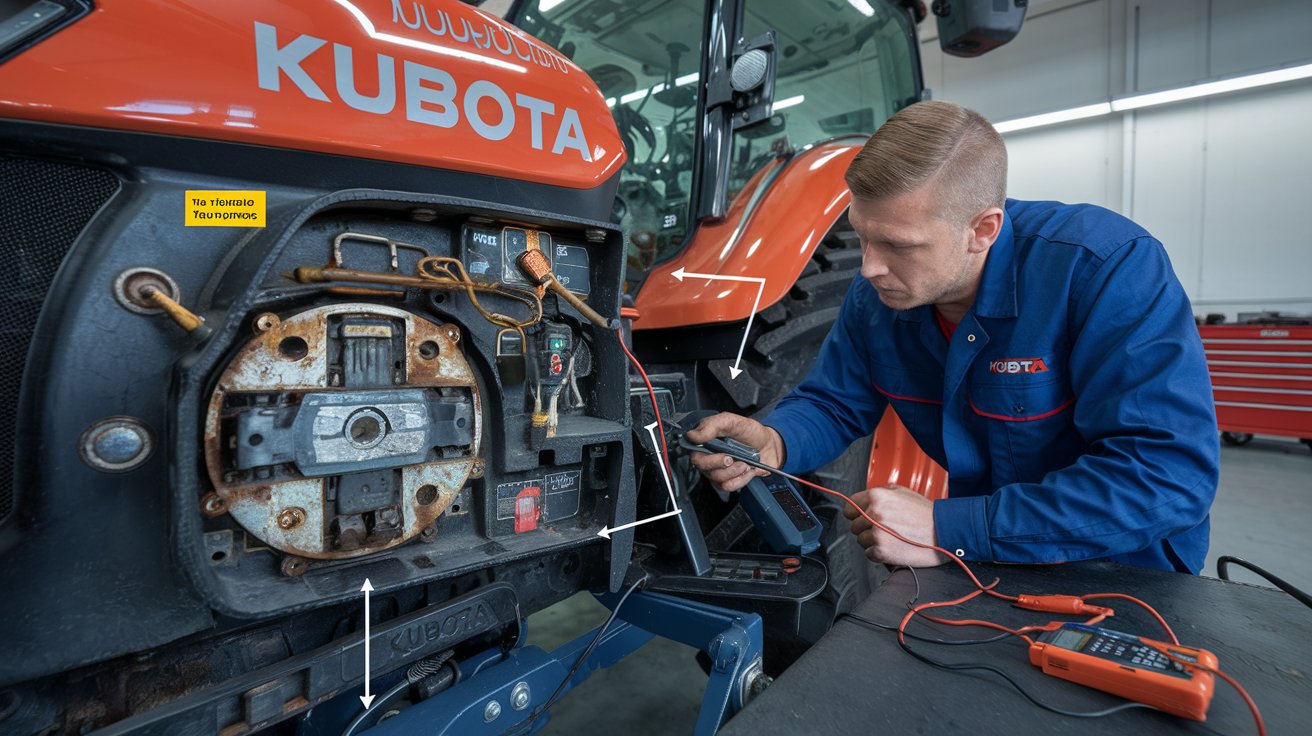Understanding the Kubota Fuel Shut Off Solenoid
The fuel shut off solenoid plays a vital role in Kubota engines, ensuring efficient and safe operation. This small but essential component acts as a gatekeeper for fuel flow, allowing the engine to start and stop on command. When the solenoid functions correctly, it supports optimal performance and prevents potential issues related to uncontrolled fuel delivery. However, when problems arise, they can lead to engine performance challenges.
Function of the Fuel Shut Off Solenoid in Kubota Engines
The solenoid works as an electrically controlled valve that regulates fuel supply to the engine. Here’s how it functions:
- Starting the engine: When the ignition is turned on, the solenoid activates, allowing fuel to flow into the engine.
- Stopping the engine: Turning off the ignition causes the solenoid to close, cutting off the fuel supply and shutting down the engine.
This precise control is crucial for maintaining efficiency, preventing fuel wastage, and ensuring safe operation.
Importance for Engine Performance
A properly functioning fuel shut off solenoid ensures:
- Reliable engine starts and stops: Preventing delayed or incomplete shutdowns.
- Optimal fuel consumption: Avoiding unnecessary fuel use.
- Engine protection: Reducing the risk of flooding or stalling.
Failing solenoids can disrupt these processes, leading to inconsistent performance, reduced efficiency, or even engine damage.
Common Causes of Solenoid Failure
Over time, the solenoid can experience wear and tear. Below are common causes of failure:
| Cause | Description |
| Electrical Issues | Damaged wires, poor connections, or failed fuses can prevent the solenoid from functioning. |
| Contamination | Dirt, debris, or fuel contaminants can obstruct the solenoid’s internal mechanism. |
| Wear and Tear | Prolonged use leads to mechanical degradation of components. |
| Improper Voltage | Overvoltage or undervoltage can cause the solenoid coil to fail. |
Addressing Kubota Fuel Shut Off Solenoid Problems
To minimize issues:
- Regular maintenance: Clean and inspect the solenoid during routine servicing.
- Check electrical connections: Ensure all wiring and terminals are secure.
- Use quality fuel: Prevent contamination by using clean, high-quality fuel.
- Prompt replacement: Replace the solenoid at the first sign of failure to avoid further damage.
Engine Starting Issues in Kubota Tractors: A Focus on Fuel Shut Off Solenoid Problems
Experiencing starting issues with your Kubota tractor can be frustrating, particularly when you’re relying on it for time-sensitive tasks. Among the potential culprits, problems with the fuel shut off solenoid are often overlooked. This component is essential for regulating fuel flow, and any malfunction can lead to significant starting difficulties. Understanding these issues can help you troubleshoot effectively and maintain optimal tractor performance.
Common Starting Problems Related to the Fuel Shut Off Solenoid
- Difficulty Starting or No Start Condition
A faulty solenoid can block the fuel supply, preventing the engine from starting altogether. Common signs include:- The engine cranks but fails to start.
- A lack of fuel delivery during ignition.
- Intermittent Starting Problems
Intermittent starting can result from:- Loose or corroded electrical connections to the solenoid.
- An aging solenoid that operates inconsistently due to internal wear.
- Unusual Noises During Startup Attempts
When attempting to start the engine, unusual sounds like clicks or buzzing can indicate:- A weak solenoid coil struggling to engage.
- Mechanical binding within the solenoid mechanism.
Diagnosing the Problem
A systematic approach to diagnosis can save time and effort:
| Symptom | Possible Cause | Suggested Action |
| No engine start | Solenoid not activating due to electrical failure | Check wiring, fuses, and battery voltage. |
| Engine starts intermittently | Loose connections or damaged solenoid | Inspect and secure all connections. |
| Clicking or buzzing sounds | Weak solenoid coil or mechanical binding | Test solenoid operation and replace if needed. |
Addressing Kubota Fuel Shut Off Solenoid Problems
To resolve and prevent solenoid-related starting issues:
- Inspect electrical connections: Tighten loose terminals and replace corroded components.
- Test the solenoid: Use a multimeter to check for proper voltage and continuity.
- Regular maintenance: Include solenoid inspection during routine servicing.
- Replace when necessary: A non-functional solenoid should be replaced promptly to avoid further complications.
Running Performance Problems in Kubota Tractors: Identifying Fuel Shut Off Solenoid Issues
If your Kubota tractor is experiencing performance problems such as stalling, poor acceleration, irregular idling, or increased fuel consumption, a malfunctioning fuel shut off solenoid could be the underlying issue. This critical component regulates fuel flow to the engine, and any failure can lead to inconsistent operation and reduced efficiency.
Common Running Performance Issues Linked to the Fuel Shut Off Solenoid
- Engine Stalling Unexpectedly
- Symptom: The engine shuts off suddenly during operation.
- Possible Cause: The solenoid intermittently closes due to electrical faults or internal wear, cutting off fuel supply.
- Poor Acceleration or Power Loss
- Symptom: The tractor struggles to gain speed or lacks the power needed for tasks.
- Possible Cause: A partially functioning solenoid restricts adequate fuel flow, limiting engine performance.
- Irregular Idling
- Symptom: The engine idles unevenly, with fluctuations in RPMs.
- Possible Cause: Contaminants or mechanical issues within the solenoid disrupt consistent fuel delivery.
- Increased Fuel Consumption
- Symptom: Noticeable rise in fuel usage without an increase in workload.
- Possible Cause: Faulty solenoid operation can lead to inefficient combustion due to inconsistent fuel flow.
Diagnosing Running Performance Problems
To pinpoint the solenoid as the root cause, use the following diagnostic table:
| Symptom | Potential Cause | Recommended Action |
| Engine stalling | Electrical failure or internal solenoid wear | Test solenoid continuity and replace if needed. |
| Power loss or poor acceleration | Restricted fuel flow due to solenoid malfunction | Inspect solenoid for blockages or damage. |
| Irregular idling | Dirt or debris inside the solenoid | Clean or replace the solenoid. |
| Increased fuel consumption | Inconsistent fuel regulation | Ensure proper solenoid operation. |
Addressing Kubota Fuel Shut Off Solenoid Problems
To improve running performance and prevent recurring issues:
- Inspect and clean the solenoid regularly: Dirt and fuel contaminants can clog the mechanism.
- Check electrical connections: Ensure proper voltage and fix loose or damaged wires.
- Replace faulty solenoids promptly: Prolonging the issue can lead to more significant engine problems.
- Use high-quality fuel: Minimize contamination risks that can impact solenoid performance.
Diagnosing and Addressing Kubota Fuel Shut Off Solenoid Problems
When diagnosing Kubota fuel shut off solenoid problems, it’s essential to focus on both electrical system indicators and physical inspection signs. Proper diagnostic methods and knowing when to seek professional help can save time and prevent costly repairs. Here’s a comprehensive guide to troubleshooting these issues effectively.
Electrical System Indicators
Electrical problems often point to fuel shut off solenoid issues. Pay attention to these signs:
- Warning Lights on the Dashboard
- If your dashboard displays warning lights, especially related to the fuel system, the solenoid may not be functioning properly.
- A malfunctioning solenoid can disrupt fuel flow, triggering alerts in the electrical system.
- Battery Drainage Issues
- A failing solenoid may draw excessive current, causing unnecessary battery drain.
- Inspect for improper grounding or short circuits in the solenoid wiring.
- Blown Fuses Related to the Fuel System
- Repeatedly blown fuses are a common sign of electrical faults within the solenoid.
- Check for damaged wires, faulty connectors, or internal solenoid failures causing circuit overloads.
Physical Inspection Signs
Visual inspection can reveal immediate clues about solenoid health:
- Visible Damage or Corrosion on the Solenoid
- Look for cracks, rust, or corrosion on the solenoid housing, as these may indicate wear or exposure to harsh conditions.
- Loose or Damaged Wiring Connections
- Inspect all wires leading to the solenoid for signs of fraying, disconnection, or corrosion.
- Secure any loose connections to ensure proper current flow.
- Fuel Leaks Around the Solenoid Area
- Leaks can occur due to worn seals or improper installation.
- A leaking solenoid can reduce fuel pressure and lead to performance problems.
Diagnostic Methods
Accurate diagnostics can pinpoint the exact problem. Use these methods:
| Method | Purpose | How to Perform |
| Multimeter Test | Measures solenoid resistance to detect electrical faults. | Set the multimeter to ohms, connect to solenoid terminals, and compare to manufacturer specifications. |
| Click Test | Confirms solenoid activation when energized. | Listen for a clicking sound as the solenoid engages. |
| Fuel Pressure Check | Verifies adequate fuel delivery to the engine. | Use a fuel pressure gauge to ensure proper flow. |
| Computer Diagnostic Scan | Identifies error codes linked to the solenoid or fuel system. | Use an OBD-II scanner or similar tool to retrieve fault codes. |
When to Seek Professional Help
If basic troubleshooting doesn’t resolve the issue, it may be time to involve a professional. Consider these situations:
- Symptoms Persist After Troubleshooting
- If the solenoid issues continue despite cleaning, testing, or replacing parts, further diagnosis may require advanced tools or expertise.
- Lack of Specialized Tools or Expertise
- Professional technicians have access to advanced diagnostic equipment, ensuring accurate identification of the problem.
- Warranty Considerations
- Repairing the solenoid or associated systems may void your tractor’s warranty if done improperly. Always check warranty terms before proceeding.
- Safety Concerns with Fuel System Repairs
- The fuel system involves flammable materials and high-pressure components. If you’re unsure, it’s safer to consult a qualified technician.
Tips for Preventing Future Problems
To minimize future solenoid-related issues:
- Regularly inspect and clean the solenoid and its connections.
- Use high-quality fuel to reduce contamination risks.
- Perform periodic electrical system checks to identify potential faults early.
FAQs About Kubota Fuel Shut Off Solenoid Problems
- What are common signs of a faulty fuel shut off solenoid?
- Difficulty starting or failure to start.
- Engine stalls unexpectedly during operation.
- Unusual noises during start-up attempts, such as clicks or buzzing.
- Irregular idling or a sudden increase in fuel consumption.
- How can I diagnose solenoid issues in my Kubota tractor?
- Inspect wiring and connections: Look for loose, damaged, or corroded wires.
- Perform a click test: Listen for a clicking sound when the solenoid is activated.
- Use a multimeter: Check the solenoid’s resistance and compare it to the manufacturer’s specifications.
- Check for fuel leaks: Inspect the solenoid area for signs of leaks or damage.
- Can I fix solenoid problems myself?
- Yes, many issues, such as loose connections or minor contamination, can be resolved with basic tools and maintenance.
- However, for problems requiring advanced diagnostics or involving the fuel system’s safety, seeking professional assistance is recommended.
- What causes solenoid problems?
- Electrical issues: Faulty wiring, poor grounding, or damaged fuses.
- Wear and tear: Over time, internal components can degrade.
- Contamination: Dirt or debris in the fuel system can obstruct the solenoid’s function.
- When should I replace the solenoid?
- If the solenoid fails multiple tests or shows visible damage, replacement is the best course of action.
Conclusion
Addressing Kubota fuel shut off solenoid problems quickly ensures your tractor operates efficiently and safely. Regular inspections, proper maintenance, and using quality fuel can prevent many common issues. For persistent problems or complex repairs, consulting a professional ensures accuracy and safety. If you’ve experienced solenoid issues or have additional questions, share your thoughts—we’re here to assist!

